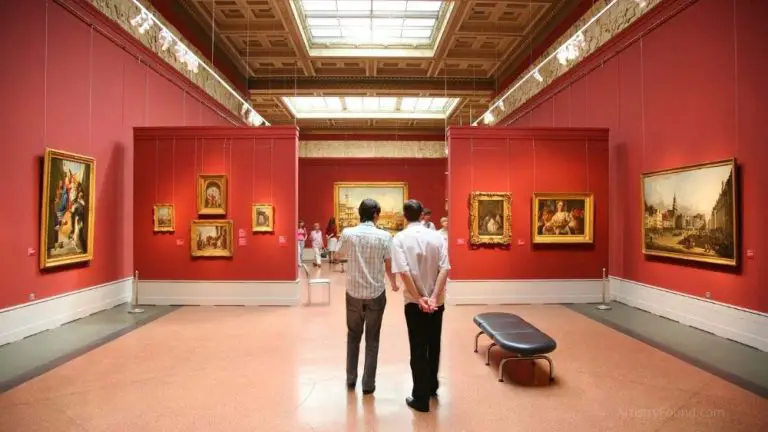The Paintings In The National Gallery (Originals or Fakes?)
The National Gallery in London is a place where people can enjoy artists’ masterpieces from across the centuries. However, people often question the originality of the paintings and how they came to be here in the first place. So, are the paintings exhibited in the National Gallery originals or fakes?
The paintings hanging in The National Gallery are originals. Although many art museums use replicas to show something from a specific time period, The National Gallery prides itself on the originality of its collections, and they want people to experience the real thing rather than a fake one.
Below, I will discuss the dilemma over the originality of the paintings exhibited in The National Gallery. I will talk about their policies and how they work, so you will see how the National Gallery values everything shown to visitors. When it comes to art, it is essential to learn how a particular museum gets its artwork and how they assess and learn about the origin of a specific art piece.
The Originality Of The Paintings In The National Gallery

(This article may contain affiliate links and I may earn a commission if you make a purchase)
The National Gallery is one of the oldest art museums in the world, which offers visitors the experience of looking at numerous historic masterpieces done over the centuries. Many of the paintings represent important events for humankind and society. If you’re in this area of London, you should not miss a chance to visit this place, especially if you are really into art.
The National Gallery strictly displays original paintings and other artwork in its exhibits. Since it maintains a long tradition of original artwork, institutions like this need to maintain their impeccable reputations. This means that the National Gallery never uses replicas or fake paintings in their collections and exhibitions.
It is a widely known fact that the National Gallery and many other art museums worldwide have more than a few forgeries in their storage; however, they never show those pieces to the public. The National Gallery has a specific protocol for checking the facts about every art piece that enters the museum. They have their own way of doing the research before exposing a particular artwork to the public.
The National Gallery Research
One of the most important activities of the National Gallery is the constant and thorough research on paintings and other artwork. Good research is the fundamental characteristic of an art museum that displays original art pieces to the public. The purpose of research is for the Gallery to cover most of the areas related to art, such as:
- Exhibitions, publications, and scholarly catalogs.
- Preservation and care of the paintings and other artwork.
- The display of the artwork and its interpretation.
Only by taking these things into account can the National Gallery keep its standards high and continue to be recognized as one of the best art museums in the world. The research they do contributes to and impacts each collection and exhibition of paintings and how they are displayed and observed by the public.
Research Of Paintings at The National Gallery
When it comes to discovering the origins of a painting and determining whether it is the original or a forgery, the National Gallery does several things to ensure proper and successful research. The Gallery investigates the following items thoroughly:
- Who painted the work, when, how, and why the paintings were created.
- Who ordered, auctioned, and collected them.
- In what way they were used.
- Their meaning and interpretation.
These factors have a significant impact on the quality of the National Gallery’s collections. As a prestigious and worldwide institution, the Gallery needs to have all of the facts before displaying a specific piece of art. As I previously mentioned, the National Gallery prides itself on the originality of its paintings; therefore, being familiar with all of the facts about a certain painting or artwork is of crucial importance to gauge its authenticity.
Overview Of The National Gallery Collections
The National Gallery possesses one of the most significant collections of paintings made throughout recorded history and has a vital role in preserving historical artwork. These paintings and other artwork belong to the public; therefore, the entrance to the National Gallery is free of charge.
The National Gallery Collections include over 2,300 pieces of artwork covering many different periods. The collections are displayed according to the century they were created or by a significant event they represent.
Here’s how the National Gallery breaks down and groups its collections by century:
- 13th to 15th century.
- 16th century.
- 17th century.
- 18th to early 20th century.
13th-15th Century
This collection encompasses the works of Duccio, Uccello, van Eyck, Lippi, Mantegna, Botticelli, Dürer, Bellini, and Memling. These paintings primarily included religious motives and were created to be displayed in churches and used over altars for private devotion. Most of them are made and decorated with gold-leaf backgrounds.
The 15th century is also the time when artists started painting creatures from mythology. Therefore, many of the paintings of this collection include mythological characters, along with details of realism.
16th Century
The leading artists of this collection are Leonardo, Michelangelo, Cranach Raphael, Bruegel, Bronzino, Holbein, Titian, and Veronese. These artists represent the birth of the renaissance, particularly in Italy.
These paintings include many portraits since the renaissance was when man was celebrated as an individual. These paintings often included religious elements in the background.
17th Century

This collection consists of the works of Caravaggio, Rubens, Poussin, Van Dyck, Velázquez, Rembrandt, Cuyp, Vermeer, and Claude. Their paintings include landscapes, still lifes, and images of everyday life. This collection represents the flamboyant and individual style of the time.
18th To Early 20th Century
The collection of the period between the 18th to 20th centuries encompasses the paintings of Van Gogh, Canaletto, Goya, Turner, Constable, Ingres, Degas, Cézanne, and Monet. This was a period of independent styles; therefore, these paintings include a lot of imagery of rebellion and non-conformity prevalent during the time.
Conclusion
It can be said with great certainty that the National Gallery in London, England displays only original paintings. By understanding the policies and rules in which they are conducting their work, you can be sure that when you see the paintings at the National Gallery, you are looking at the original artwork by the original artist.






